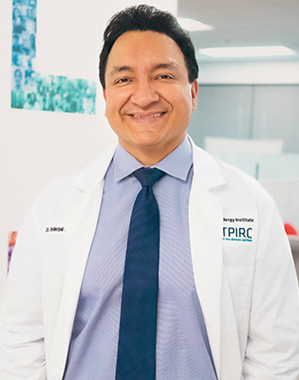Transform Allergy Care. Together.
Partner with Food Allergy Institute
Join thousands of providers worldwide referring patients to the Food Allergy Institute. Powered by data and guided by science, our team helps children and adults achieve remission from food allergies through the Tolerance Induction Program® (TIP).
Why Providers Refer to Us
At the Food Allergy Institute, we believe remission—not lifelong avoidance—is the solution. Our outcomes speak for themselves:
-
.png)
<1%
Reaction Rate During Treatment
-
.png)
56,000
Foods Introduced and Challenged Annually
-
.png)
91%
Patients Have Multiple Food Allergies
-
.png)
75%
Present with Comorbidities
Our provider network includes allergists, pediatricians, GI doctors, pulmonologists, and functional medicine physicians across the U.S.
The Tolerance Induction Program®:
The New Standard of Food Allergy Care
TIP is a data-driven, individualized treatment program that retrains the immune system to tolerate food. Unlike conventional protocols focused on desensitization, TIP leverages biomarker analysis, biosimilar proteins, and AI-driven treatment planning to achieve true food freedom.
-
1
Comprehensive diagnostics (IgE, IgG4, basophil, skin prick)
The Tolerance Induction Program® (TIP) begins with a robust diagnostic process incorporating IgE, IgG4, Basophil Activation Tests (BAT), and skin prick testing. These tools allow for deep immune profiling, identifying not only the presence of food-specific IgE but also modulating markers like IgG4 and basophil reactivity. This comprehensive dataset forms the basis for individualized treatment plans and tracks immunologic shifts over time, offering clear insight into progression toward remission.
-
2
Immune system mapping with machine learning
Using trillions of data points, TIP employs a proprietary machine learning platform to map each patient’s immune system and define specific endotypes. The resulting Allergy Snapshot—a dynamic visual representation of immune sensitivity—enables real-time monitoring of progress and precision prediction of treatment response. This platform analyzes shifts in immunoglobulins and cellular responses to optimize the Food Dosing Strategy and support long-term immune retraining.
-
3
Controlled exposure using biosimilar proteins
TIP’s treatment protocol uses biosimilar proteins—non-allergenic, structurally similar proteins—to condition the immune system safely before introducing primary allergens. These proteins exploit shared IgE-binding domains across allergen superfamilies (e.g., Ara h in peanuts and related seed/tree nut proteins) to gradually shift the immune response from sensitization to tolerance. This approach significantly reduces risk, maintains reaction rates below 1%, and primes the immune system for successful allergen challenge.
-
4
Precision Protein Gummy Dosing
Allergen-specific gummies developed in TIP’s in-house lab provide highly controlled, pharmaceutical-grade dosing tailored to each patient’s unique immune profile. These microdosed gummies ensure exact protein delivery in age- and weight-adjusted amounts, supporting consistent at-home therapy. This format promotes adherence, simplifies dosing logistics for families, and enables precise immune training with minimal risk.
-
5
In-office challenges based on biomarker readiness
Food introductions and oral food challenges are conducted in-clinic only after biomarker trends—such as reductions in IgE and basophil reactivity—indicate readiness. Each challenge serves as a functional test of immune modulation, with progression determined by real-time lab data and machine learning insights. This strategy ensures safety while confirming tolerogenic milestones prior to advancing the patient through subsequent dosing phases.
-
6
Remission: ability to eat freely without daily dosing
TIP defines remission as sustained immune tolerance—seven days of unresponsiveness to allergenic proteins with weekly exposure only. Unlike desensitization protocols requiring daily maintenance, patients in remission can eat freely without label checking, reactogenic anxiety, or food avoidance. Over 8,000 patients have achieved this milestone, with long-term remission supported through gradually tapered maintenance dosing guided by follow-up labs and ongoing immune monitoring.

A True Clinical Partnership
Whether you’re a specialist or primary care provider, TIP is designed to work alongside your care plan. Our team provides shared updates, lab results, and treatment progress through our secure patient systems—ensuring continuity of care and full transparency.
“It’s not about replacing your care. It’s about enhancing it—with tools that create measurable impact.”
Meet the Clinical Leadership Team
TIP was developed by a team of allergy, immunology, and data science experts committed to redefining food allergy treatment.

Medical Officer

Clinical Services

Software Development




Medical Officer

Clinical Services
Dr. Tracy Clark completed her medical education at Vanderbilt University Medical School and underwent pediatric training at the Children’s Hospital of Los Angeles.
For over a decade, Dr. Clark worked alongside Food Allergy Institute Founder, Dr. Inderpal Randhawa, as a Pediatric Hospitalist at Miller Children’s Hospital in Long Beach. There, Dr. Clark gained extensive experience and expertise in treating a multitude of pediatric conditions. In 2018, Dr. Clark focused her career on helping children overcome their severe food allergies at the Food Allergy Institute.
As Vice President of Clinic Operations, Dr. Clark plays a pivotal role in upholding our exemplary quality of care at the Food Allergy Institute's two Southern California locations. Her commitment to driving patient outcomes, fostering a positive and collaborative clinic environment, and pushing forward innovative solutions underscores her invaluable contributions to the field of pediatric medicine and food allergy treatment.
As an inspiring and respected clinical leader, Dr. Clark strives to continually improve clinical operations and empower patients to lead the fullest lives possible. “I love giving the gift of food, adventure, and the freedom for patients to live their best life.”

Software Development
Herman Sandhu is the Senior Software Manager at the Food Allergy Institute, where he pioneers the intersection of healthcare and technology. As one of the minds behind the machine learning software that powers FAI’s Tolerance Induction Program® (TIP), Herman leads a team of data scientists in transforming complex clinical data into personalized treatment plans.
With a Bachelor’s degree in Healthcare Administration and a Master’s in Information Systems, Herman blends engineering, analytics, and automation to enhance the safety, efficiency, and precision of TIP treatment. A founding team member since 2012, he brings both technical leadership and a deeply patient-centered spirit to everything he does.
Having personally lived with food allergies, Herman is profoundly connected to FAI’s mission of achieving Food Freedom for all. He understands firsthand the fear and isolation that can come with avoidance-based approaches and is committed to building solutions that change that narrative.
“The most fulfilling part of working at FAI is the impact the work has on our patients in real-time. Being on the receiving end of families’ love and gratitude—before, during, and after treatment—is a reward few experiences can match, especially in a professional capacity. I’m honored to contribute to a solution that many never thought possible for a problem they feared would haunt them for life.”

Dr. Nathan Marsteller is the Director of Research at the Translational Pulmonary and Immunology Research Center (TPIRC), where he leads a translational science program focused on rare diseases, food allergy, and lung development. Since 2017, he has built a research infrastructure that leverages large-scale data to advance diagnostics, patient-focused methodologies, and studies on immune regulation.
He holds a Ph.D. in Biological Sciences from the University of Nebraska–Lincoln and brings over 15 years of experience in immunology, pulmonology, and molecular biology.
Dr. Marsteller also serves as Research Faculty at the University of California, Irvine, within the Pediatric Pulmonology Division at Miller Children’s Hospital, where he mentors fellows in the Pulmonology Fellowship Program.
His commitment to advancing food allergy research is evident in his role as Principal Investigator of the TPIRC Biobank, a biospecimen and data resource he has led since 2020. The initiative stores and manages biological samples and patient data, supporting the development of new diagnostics and treatments for food anaphylaxis and driving innovation within the Tolerance Induction Program™ at the Food Allergy Institute.

With over a decade of experience in food science, Shin Nagane serves as the Principal Food Scientist at the Food Allergy Institute’s in-house Food Laboratory.
He earned a Bachelor of Science in Biology from UC Irvine and a Master of Science degree in Food Science and Technology from Chapman University. Before joining FAI, Shin spent nine years in the plant-based food industry, leading research and development for new products and process optimization.
At FAI, Shin is responsible for developing and refining ready-made food doses that ease the burden of at-home preparation while ensuring accurate, safe dosing for patients undergoing TIP treatment. Drawn to FAI’s groundbreaking approach, moving beyond avoidance to address food allergies at their root, Shin brings a spirit of curiosity and innovation to everything he creates.
“At FAI, I am able to make a difference through producing products that help patients progress through the program to achieve food freedom.”

Peter Ngo is the Laboratory Manager at TPIRC Diagnostics, the in-house laboratory supporting the Food Allergy Institute. With over 17 years of experience in laboratory diagnostics, including a decade leading allergy testing for the West Coast at Quest Diagnostics, Peter oversees all lab functions, from infrastructure to execution.
He holds a Bachelor of Science in Biology from UC San Diego and completed graduate studies in Network and Communications Management at DeVry University.
The diagnostics developed by his team form the foundation of every TIP treatment plan, ensuring each is personalized, precise, and safe. Under his leadership, FAI has built one of the largest allergy specialty labs in the world, redefining diagnostic standards through innovation and patient-first design.
Peter is especially proud of how the lab connects directly with the families it supports, bringing greater meaning to every sample processed. “Working in standard laboratories, all we get to see are test tubes and patient samples. Here, I get to put a face with the patient sample I am testing, and that really creates a personal connection in what I am doing and the meaningfulness behind why we do this.”







Dr. Tracy Clark completed her medical education at Vanderbilt University Medical School and underwent pediatric training at the Children’s Hospital of Los Angeles.
For over a decade, Dr. Clark worked alongside Food Allergy Institute Founder, Dr. Inderpal Randhawa, as a Pediatric Hospitalist at Miller Children’s Hospital in Long Beach. There, Dr. Clark gained extensive experience and expertise in treating a multitude of pediatric conditions. In 2018, Dr. Clark focused her career on helping children overcome their severe food allergies at the Food Allergy Institute.
As Vice President of Clinic Operations, Dr. Clark plays a pivotal role in upholding our exemplary quality of care at the Food Allergy Institute's two Southern California locations. Her commitment to driving patient outcomes, fostering a positive and collaborative clinic environment, and pushing forward innovative solutions underscores her invaluable contributions to the field of pediatric medicine and food allergy treatment.
As an inspiring and respected clinical leader, Dr. Clark strives to continually improve clinical operations and empower patients to lead the fullest lives possible. “I love giving the gift of food, adventure, and the freedom for patients to live their best life.”

As the Chief Operating Officer at the Food Allergy Institute, Anoop Lohara leads operational strategy that drives sustainable organizational growth and expands access to life-changing food allergy treatment. He also serves as the Chief Financial Officer at TPIRC, FAI’s parent organization dedicated to advancing treatment for rare diseases.
Throughout his 25-year career, Anoop has held leadership roles at Advantage Solutions (Leonard Green portfolio company), Bank of America, Amgen, and top consulting firms, including Ernst & Young. His expertise spans operations, finance, and technology strategy, with a focus on building systems that drive innovation and long-term impact.
Known for his thoughtful and steady leadership, Anoop provides the operational foundation for FAI’s continued momentum. What motivates him most is seeing the tangible results of his work every day.
“It is rare to find an opportunity where you can see, on a daily basis, the impact your work has in changing people's lives for the better. At FAI, our growth goes hand-in-hand with helping more children overcome their life-threatening food allergies.”

For over 20 years, Matias Coo has led efforts to bring innovative healthcare solutions to patients in need. As VP of Patient Acquisition and Experience at the Food Allergy Institute, he oversees marketing, enrollment, business development, and customer service teams, driving growth at scale.
Recognized as one of MM&M’s Top 40 Healthcare Transformers, Matias has held senior positions at leading healthcare organizations, including Medtronic, Avanir and Otsuka Pharmaceuticals, and Danaher Life Science Companies.
After witnessing his daughter’s transformation through TIP, Matias joined FAI in 2022 to help extend that same hope to families everywhere. His leadership has played a pivotal role in shaping the evolution of TIP and establishing FAI as a leader in food allergy treatment.
“We are at the forefront of a massive shift in healthcare—redefining how disease is approached scientifically and treated medically. What excites me most is shortening the path to standard of care from decades to just a few years. It’s a privilege to introduce families to FAI and the hope TIP provides.”

Bringing over 20 years of experience in financial management, Brian Kim serves as the Chief Financial Officer at the Food Allergy Institute (FAI), where he leads the organization’s financial strategy, planning, and growth initiatives.
Before joining FAI, Brian held senior leadership roles across a range of industries, including Senior Manager of Strategy and Finance at Chipotle, FP&A Principal at SCAN Health Plan, and Vice President of Private Equity and Venture Capital at Kline Hawkes.
At FAI, Brian champions transparency, cross-functional collaboration, and data-driven decision-making. With a deep belief in FAI’s disruptive mission, he focuses on scaling its impact and expanding access to its transformative food allergy solution.
“FAI's mission is especially meaningful because it can help deliver hope to families that have struggled with the emotional and physical toll of living with food allergies. Its outcome-based and data-driven approach provides families with the simple reassurance that is often absent in health care today.”

Herman Sandhu is the Senior Software Manager at the Food Allergy Institute, where he pioneers the intersection of healthcare and technology. As one of the minds behind the machine learning software that powers FAI’s Tolerance Induction Program™ (TIP), Herman leads a team of data scientists in transforming complex clinical data into personalized treatment plans.
With a Bachelor’s degree in Healthcare Administration and a Master’s in Information Systems, Herman blends engineering, analytics, and automation to enhance the safety, efficiency, and precision of TIP treatment. A founding team member since 2012, he brings both technical leadership and a deeply patient-centered spirit to everything he does.
Having personally lived with food allergies, Herman is profoundly connected to FAI’s mission of achieving Food Freedom for all. He understands firsthand the fear and isolation that can come with avoidance-based approaches and is committed to building solutions that change that narrative.
“The most fulfilling part of working at FAI is the impact the work has on our patients in real-time. Being on the receiving end of families’ love and gratitude—before, during, and after treatment—is a reward few experiences can match, especially in a professional capacity. I’m honored to contribute to a solution that many never thought possible for a problem they feared would haunt them for life.”

Dr. Nathan Marsteller is the Director of Research at the Translational Pulmonary and Immunology Research Center (TPIRC), where he leads a translational science program focused on rare diseases, food allergy, and lung development. Since 2017, he has built a research infrastructure that leverages large-scale data to advance diagnostics, patient-focused methodologies, and studies on immune regulation.
He holds a Ph.D. in Biological Sciences from the University of Nebraska–Lincoln and brings over 15 years of experience in immunology, pulmonology, and molecular biology.
Dr. Marsteller also serves as Research Faculty at the University of California, Irvine, within the Pediatric Pulmonology Division at Miller Children’s Hospital, where he mentors fellows in the Pulmonology Fellowship Program.
His commitment to advancing food allergy research is evident in his role as Principal Investigator of the TPIRC Biobank, a biospecimen and data resource he has led since 2020. The initiative stores and manages biological samples and patient data, supporting the development of new diagnostics and treatments for food anaphylaxis and driving innovation within the Tolerance Induction Program™ at the Food Allergy Institute.
-
Pantaleon®
AI-Powered EMR & Diagnostic Platform
Our proprietary platform combines machine learning with clinical expertise for precision treatment planning.
-
.png)
What Providers Are Saying
From primary care to specialists, providers rely on TIP as a trusted partner in care—supporting patients through every step of their treatment journey. With a collaborative approach, transparent communication, and global reach, we ensure each referring provider stays informed and aligned throughout the process.
Dr. Mohtasham completed her pediatric pulmonary fellowship at the Pediatric Pulmonary Division at Jackson Memorial Hospital, University of Miami. In 2008, she joined the Division of Pulmonary and Sleep Medicine at the Children's Hospital of Philadelphia, where she cared for complex pulmonary cases, including asthma, cystic fibrosis, BPD, PCD, ILD, technology-dependent children, sleep disorders, and pre- and post-lung transplant patients until 2020. She currently serves as an attending physician at Lung & Allergy Health Associates (LAHA).
"I believe close collaboration between TIP and a pediatric pulmonologist makes a significant difference for these groups of patients, and by treating food and environmental allergies and asthma simultaneously, we can make a great impact on these patients' lives."
MD, Pediatrics, Allergy, & Immunology
Dr. Omar Yamak, M.D., a respected Allergist, completed his Allergy and Immunology Fellowship at Children’s Hospital of Michigan/Detroit Medical Center and his General Pediatrics Residency at Children’s Hospital of the King’s Daughters and Eastern Virginia Medical School. Today, Dr. Yamak is an attending physician at Lung & Allergy Health Associates (LAHA).
"It [collaborating with FAI] tends to improve patients quality of life and by simultaneously starting SLIT [Sublingual Immunotherapy], it improves allergic rhinitis and asthma as well!"
MD, Allergy and Immunology
Dr. Kourosh combines treatment modalities from cutting edge and mainstream medicine with the best of functional and integrative medicine therapies and traditional philosophies to treat the whole person in their environment. She is chair of the American College of Allergy, Asthma, and Immunology Integrative Medicine Committee and is an internationally renowned expert on holistic and integrative health.
"Food Allergy Institute's comprehensive evidence-based approach takes the guesswork and fear out of food allergen immunotherapy for families who believe in a science-based approach to healing food allergies and are ready to get started. I feel confident referring to their program and co-managing my patients with the FAI team. I share their precision medicine philosophy and look forward to learning more about my patients and about the unfolding science of oral immunotherapy through their research insights."
MD, Pediatrics, Allergy, & Immunology
Founder and Medical Director of Ocean Pediatrics, Dr. Abelowitz is a leader in the field of pediatric medicine, with a vast expertise in academic and clinical settings. He has been treating children in the Orange County area for over 29 years.
“The primary challenges my patients encounter with food allergies are lifestyle limitations, anxiety, and fear related to the dangers of food allergy, especially anaphylaxis, multiple doctor and ER visits, consistent need for medication refills, especially Epipens and Avi-Q, as well as the constant, tedious need to constantly
Complete medical forms such as school allergy and medication administration forms.
Witnessing a patient overcoming their allergies is especially rewarding and heartwarming, knowing the dramatic life-changing effect it will have. Some of the notable changes I observe when children
reach remission is an overwhelming sense of relief by the patient but especially the parents, increased confidence, and reduced anxiety.”
MD, Pediatrics
With over 25 years of experience, Dr. Michael Villadelgado brings trusted, compassionate pediatric care to Orange County Children’s Medical Group, specializing in mental health, neurodevelopmental, sleep, gastrointestinal, and immune-related conditions.
“As a healthcare provider, I've always strived to offer the best possible care and options to my patients, especially those with food allergies. Referring them to the Tolerance Induction Program for many years has been educational, life-changing, and revolutionary. Witnessing the remarkable results that my patients have achieved under their expert care has been nothing short of inspiring. Their unique process of introducing biosimilar proteins initially and the unique delivery system in place has been highly effective with lower adverse events and higher compliance among my patients. From reducing and eliminating the severity of allergic reactions to expanding dietary options, the outcomes have been transformative in the lives of many children.
Collaborating with Dr. Randhawa and his dedicated team reinforces my confidence in providing comprehensive care and ensuring my patients receive the highest standard of treatment
available.”
MD, Fellow of the American Academy of Pediatrics (FAAP)
An attending physician and Pediatric pulmonologist at Lung & Allergy Health Associates (LAHA), Dr. Stathos completed his Fellowship in Pediatric Pulmonology at Miller Children’s Hospital in collaboration with the University of California-Irvine.
"Collaborating with the Food Allergy Institute has been a great experience both taking care of FAI patients in TIP and when I see them as a pulmonary consultation. I believe close collaboration between TIP and pediatric pulmonologists makes a significant difference for this group of patients. By treating food and environmental allergies and asthma simultaneously, we can make a great impact on these patients’ life."
DO, Pediatric Pulmonology
"What a wonderful option for treating our patients with severe food allergies! Having options outside of avoidance is really a game
changer for food allergy patients. The Food Allergy Institute is a family-friendly center of excellence that offers patients the potential to significantly reduce the risk of anaphylaxis long term, and to live fuller, more normal lives without constant worry."
MD, Pediatrics
MD, Pediatric Gastroenterology
Access Clinical Tools and Educational Resources
We're committed to supporting our providers with data, research, and tools to guide their referrals and
conversations with families.
-
-1.png)
Publications
Peer-reviewed studies on TIP methodology and outcomes
-
-1.png)
Webinars & Grand Rounds
Clinical deep-dives and treatment walkthroughs
-
.png)
CME Course
Introduction to TIP for medical professionals
-
-1.png)
Provider Guide
How to refer, what to expect, and program details.
-
.png)
Provider FAQs
Common questions about TIP, timelines, and outcomes
-
-1.png)
Educational Videos
Provider walkthroughs, patient journeys, and clinical education
Get Started
-
.png)
Refer a Patient
Use our secure form to connect a patient with our clinical team. -
-1.png)
Become a Partner
Bring TIP to your patients—we’re expanding our global affiliate network. Already a partner? Click here. -
.png)
Have Questions?
Our clinical outreach team is happy to connect.
Real Stories, Real Outcomes
-
Sophia Age 7
Allergic to peanuts, dairy, eggs, and sesame. Now eats freely.
“We finally feel safe at birthday parties and school lunches.”
-
Sophia Age 7
Allergic to peanuts, dairy, eggs, and sesame. Now eats freely.
“We finally feel safe at birthday parties and school lunches.”
-
Sophia Age 7
Allergic to peanuts, dairy, eggs, and sesame. Now eats freely.
“We finally feel safe at birthday parties and school lunches.”